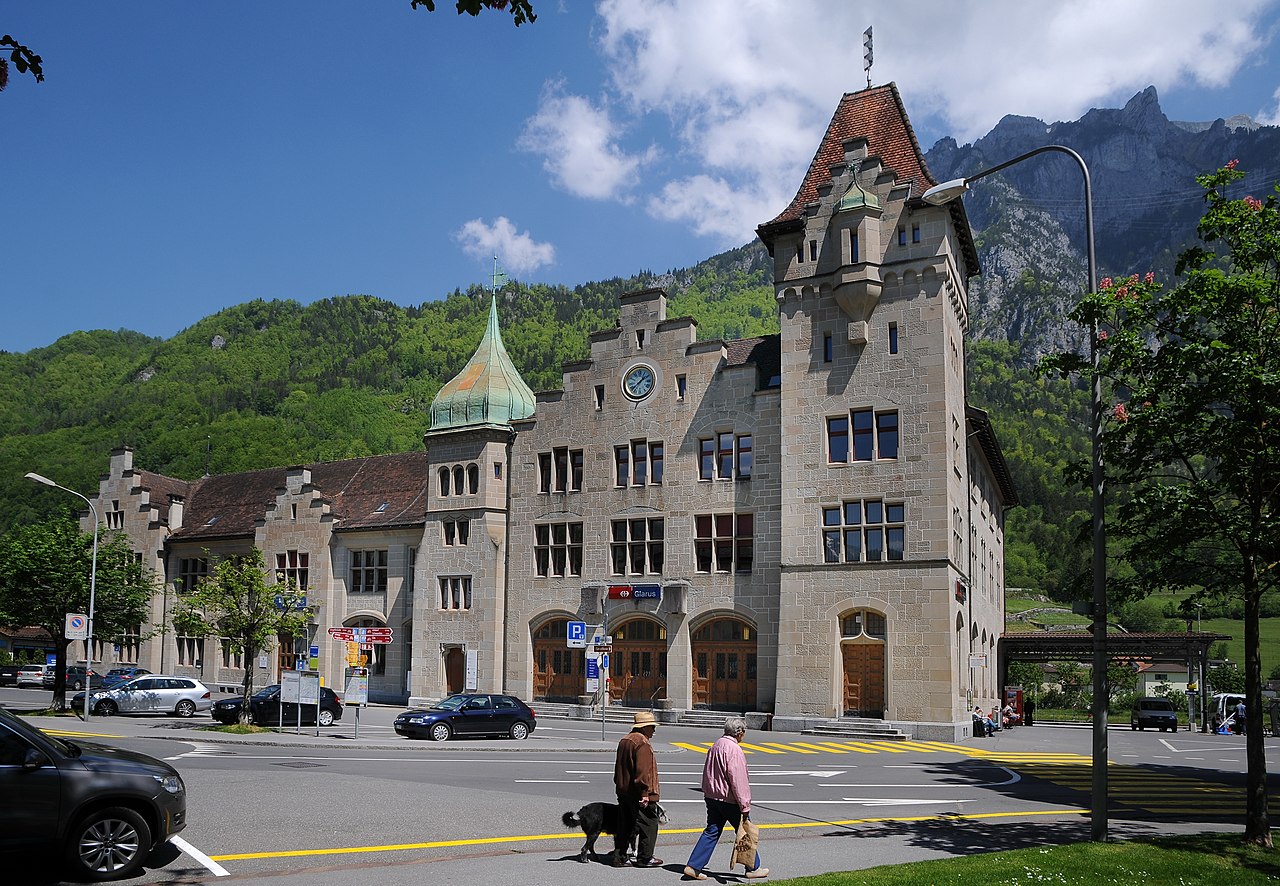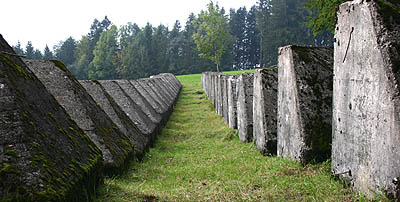Landschlacht, Switzerland, 8 January 2018
The Common Era year 2017 ended a week ago, which means the commemoration of the 500th anniversary of the Reformation also ended.
1 January 2018 was the 534th anniversary of the birth of Huldrych Zwingli, the Swiss German-speaking Reformer, whose life I have been retracing on foot through the advice of Marcel and Yvonne Steiner´s Zwingli Wege: Zu Fuss von Wildhaus nach Kappel am Albis – Ein Wander- und Lesebuch since 10 October 2018.

Above: Huldrych Zwingli (1484 – 1531)
(Please see Canada Slim and the Road to Reformation, Canada Slim and the Wild Child of Toggenburg, Canada Slim and the Thundering Hollows, Canada Slim and the Basel Butterfly Effect, Canada Slim and the Vienna Waltz, and Canada Slim and the Battle for Switzerland´s Soul of this blog for an account of the life of Zwingli in Wildhaus, Weesen, Basel, Vienna and Glarus and an account of my own experiences with these places.)
So, by all accounts, you, gentle Reader, should now be spared any more mention of Zwingli and the Reformation in Switzerland, but both Zwingli´s life and my adventures following his life did not end in Glarus.
The abovementioned book of the Steiners divides the on foot exploration of Zwingli´s life into nine stages, four of which I have walked and written about.
What follows in today´s blog is a description of my attempts to follow Zwingli from Glarus to Zürich.
There will still remain the final stage of both the book and Zwingli´s life to be followed from Zürich to his final destination of Kappel am Albis, which will be written about in a future blogpost.
I ask for the reader´s patience in retracing Zwingli´s and my footsteps, for what it is discovered en route should make for interesting reading.
(I hope.)
Glarus, Switzerland, 23 November 2017 (American Thanksgiving)
A man must accept his limitations or those limitations placed upon him.

My limitations are time (I live and work in Switzerland and obligations of my domestic life and my professional life as barista and teacher must be taken into account.), money (As much as my wife is supportive of my little pet projects she doesn´t like to see money spent too “frivolously” on overnight accommodation if a return home the same day of a hike can be arranged.) and season (Much of Switzerland´s infrastructure closed down once winter has begun and a decrease of daylight were factors that had to be considered.).
As previously mentioned in former blogposts, the Steiners don´t claim that the walking routes they recommend were actually walked by Zwingli himself, just that they lead to places where he once resided.
The Steiners recommended, in a two-stage, two-day walk, that the historic walker could walk from Glarus to Einsiedeln via the Klontalersee and the Saaspass.
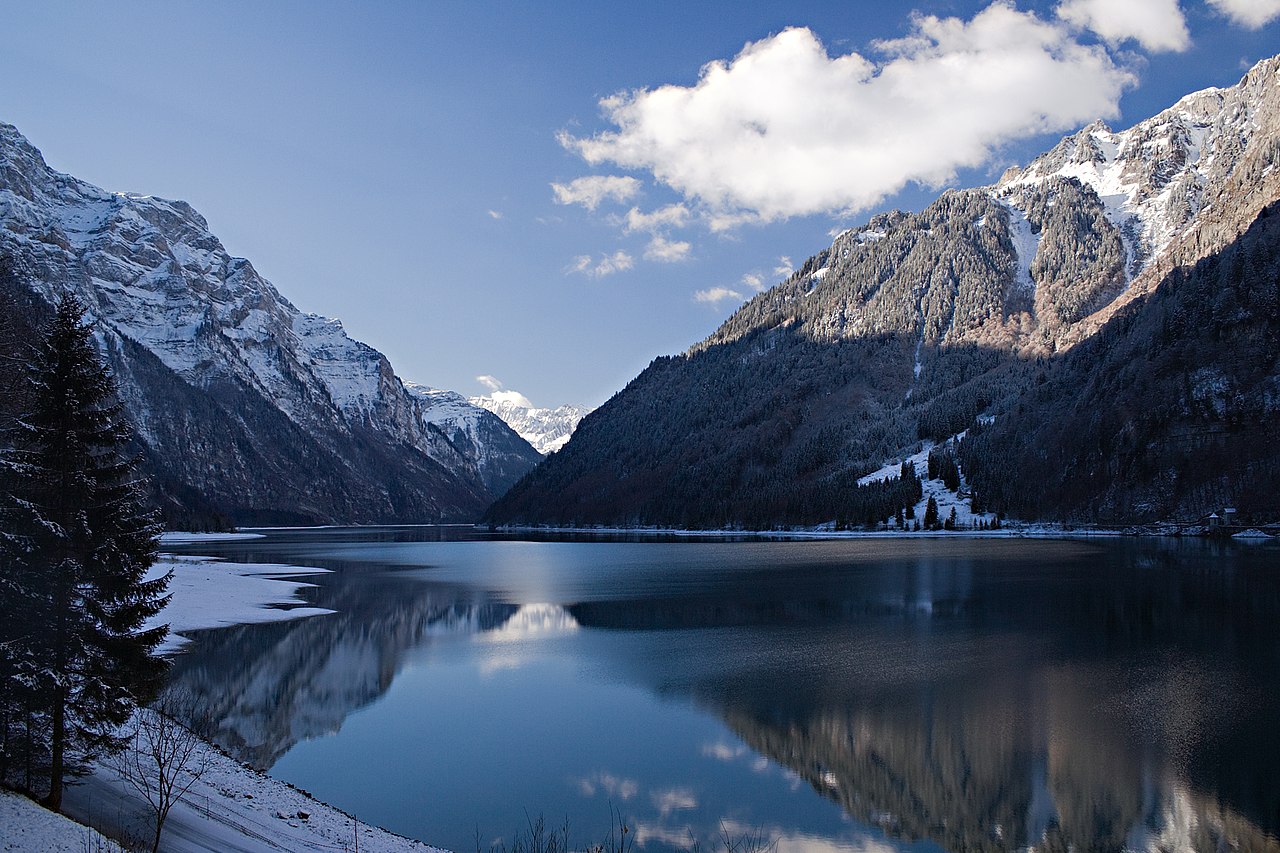
Above: Klon Valley Lake, Canton Glarus
I was keen to do so, but uncertainty as to whether these routes would be passable and visible or if they were blocked by snow, and the inability to return from the Klon Valley Lake by bus back to Glarus before darkness set in, made me reconsider the wisdom of walking to Einsiedeln in winter without the proper gear.
Arriving in Glarus and learning that buses between the Lake and Glarus were not running until April, I returned to the train station and instead decided to make the journey by train.
Above: Glarus Railway Station
Einsiedeln, Switzerland, 23 November 2017
The small village of Einsiedeln in the hills of northern Schwyz Canton has been Switzerland´s most important site of pilgrimage for a thousand years and still draws a quarter of a million devout believers every year.
The village itself is unremarkable, but the mighty Benedictine monastery which dominates it is exceptional, and worth a detour whether you are drawn by faith or curiosity.
Einsiedeln means hermitage and is named for St. Meinrad the Hermit, a monk from the monastery of Reichenau, who withdrew to what was then wilderness known as the Dark Forest in 828 AD.
Meinrad was born circa 800, somewhere between the German towns of Tübingen and Rottenburg.
His parents sent him to the world-famous monastic school at Reichenau, where he later entered the monastery.

Above: Reichenau Coat of Arms
However, his true vocation was for the life of a hermit.
He withdrew into the solitude of the Dark Forest.
The spot where the Lady Chapel stands today is where Meinrad built his hermit´s cell and oratory in 835.
He built a small chapel and living quarters and remained there 26 years until the day of his death.
And it was where he was murdered by two thieves on 21 January 861 after a life of self-denial and prayer.
They found nothing of value, because he had taken a vow of poverty and had always given away everything he received.
Two ravens that lived with Meinrad pursued the murderers and brought their crime to light.

The murderers were arrested and burnt at the stake for their crime
In commemoration of this the Abbey of Einsiedeln has since the 13th century borne two ravens on its coat of arms.
Meinrad´s body was retrieved by the monks from Reichenau and returned to their monastery, where he was reverently laid to rest.
(His body was sometime later returned to Einsiedeln where it is considered the Abbey´s most precious relic.
Meinrad´s head reposes in a silver case in the high altar of the Church.
Meinrad´s skull has got a fissure from the blow of a club.)
Following Meinrad´s death, his hermitage remained deserted for more than 40 years.
Eventually Benno, a priest from Strasbourg, settled there with a number of followers, cleared the forest and rebuilt the chapel.

Above: Strasbourg Cathedral
Benno and his followers built cells in the neighbourhood, living as hermits in an informal brotherly union.
In September 934, a relation of Benno named Eberhard of Nellenburg came to the Meinradzelle with a larger following and considerable financial resources and founded a Benedictine community, becoming the monastery´s first abbott.
Emperor Otto I (912 – 973) was in the process of building up a powerful empire like his great predecessor Charlemagne.
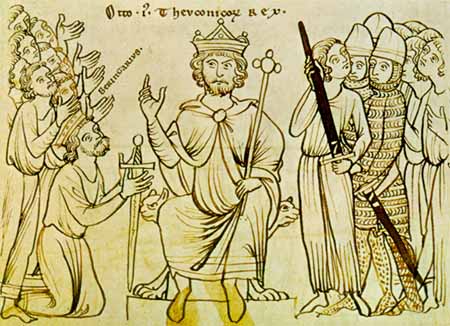
To do this he needed the support of the Church against the over-mighty princes and nobles of his realm.
Otto made bishops and abbots into worldly leaders and conferred upon them far-reaching powers and extensive landholdings.
The young monastery “in the depths of the forest” was no exception.
In the year 934 Otto signed the Document for Immediacy, making the monastery directly answerable to himself.
Abbott Eberhard invited the Bishop of Konstanz to perform the consecration of a new church on the site on 14 September 948.
The Bishop was about to do so, when a voice was heard ringing through the church, insisting three times over that God Himself had already consecrated the church.
“Desist.
God Himself has consecrated this building.”
(This Miraculous Consecration was a real time saver)
The Pope declared this to be a miracle and issued a papal bull blessing the pilgrimage to Einsiedeln.
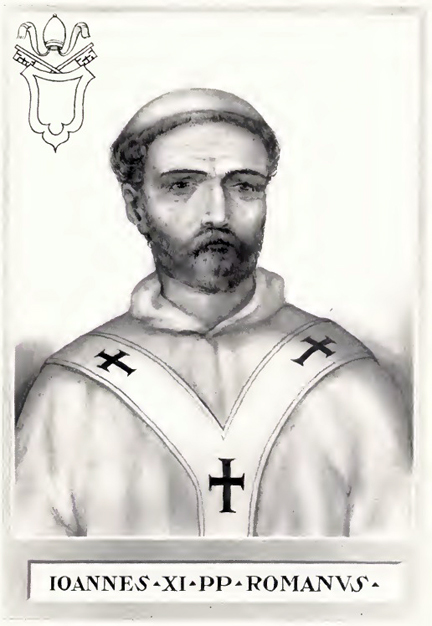
Above: John XI, Pope (931 – 935)
From then on, the monastery enjoyed special privilege, with large royal grants and positions of honour for the abbots.
Duchess Regenlind of Swabia and the Ottonian emperors provided the monastery with generous endowments, as the young religious community typified the monastic ideal.
This is attested by the works produced in the Abbey´s scriptorium.
This secular protection became a permanent bone of contention.
When the arch enemies of the Swiss, the Habsburgs took over the protectorship of the monastery in 1283, the conflict came to a head.
On the night of Epiphany 1314, the Swiss attacked the monastery, plundered it and held the monks captive for weeks.
The Habsburgs now had an excuse for the punitive expedition they had long planned against the Swiss.
However, this ended in a defeat for the Habsburgs at Morgarten, and after the Battle of Sempach, the Swiss forced the Habsburgs to return the protectorship of the monastery to them.
In the 13th century admission to the novitiate in Einsiedeln became restricted to the nobility, so by the late Middle Ages the Abbey´s membership had fallen sharply.
By 1286 the Chapel of Our Lady, built over the remains of Meinrad´s cell, was already a focal point.
It was adorned after a destructive fire in 1468 with a statuette of Mary with the infant Christ, carved in wood some time before 1440.
It is this figure which became the focus of pilgrimage as the Black Madonna.
Monza, Italy, 8 – 13 September 1515
Zwingli had marched as armed chaplain for the Glarner battalion six days from the Septimer Pass to Milan and Monza.
On Saturday 8 September, Zwingli preached a sermon from the Loggia of the Palazzo del Arengario to the assembled representatives of the fighting strength, Swiss Confederation troops and additional fighting partners.
In his sermon Zwingli warned them of defeat against the French due to disagreement within the Confederation.

Above: Basilica di San Giovanni, Melegnano (formerly Marignano)
On Sunday the Pope and the leaders of the Holy League held a Council of War here.
The attack on Marignano took place on the following Thursday 13 September due to pressure from Cardinal Schiner resulting in disastrous defeat.

Above: Battle of Marignano, 13 – 14 September 1515
Zwingli experienced, at close range, the power and political decisions of the Pope´s regency and the fatal dependence of the Confederation on mercenary warfare.
He became increasingly more doubtful of the mercenary situation.
The decisive defeat of the Swiss in the Battle of Marignano caused a shift in mood at Glarus in favour of the French rather than the Pope.
Zwingli, the papal partisan, found himself in rather a difficult position and decided to retreat to Einsiedeln.
By this time, Zwingli had become convinced that mercenary service was immoral and that Swiss unity was indispensable for any future achievements.
Some of his earliest writing, such as The Ox (1510) and The Labyrinth (1516) attacked the mercenary system using allegory and satire.
His countrymen were presented as virtuous people caught within a French, imperial and papal triangle.
Zwingli stayed in Einsiedeln for two years during which he withdrew completely from politics in favour of ecclesiastical activities and personal studies and contemplation.
Later Zwingli would write:
“I started to preach the Christian Gospel in 1516.”
His Bible studies and practical experience during his decade in Glarus were decisive contributing factors.

On the eve of the Reformation, there were only two monks left in the monastery, one who occupied the office of abbott and the other of administrator.
All pastoral duties were carried out by chaplains, amongst them Huldrych Zwingli.
As people´s priest in Einsiedeln, Zwingli took the time to consider the whole.
His humanistic competence, contacts and studies for a reliable Interpretation of the Bible absorbed him.
He came to the conclusion in Einsiedeln that essential revision was necessary within the Church and the Confederation.
The guiding principle and compass for that revision had to be the message exclusively from the Bible.
“You are God´s tools.
He requires your service, not your inactivity.”
His time in Glarus and Einsiedeln was characterised by inner growth and development.
Zwingli perfected his Greek and took up the study of Hebrew.
His personal library contained over three hundred volumes from which he was able to draw upon classical and scholastic works.
He exchanged correspondence with a circle of Swiss humanists and began to study the works of Erasmus.
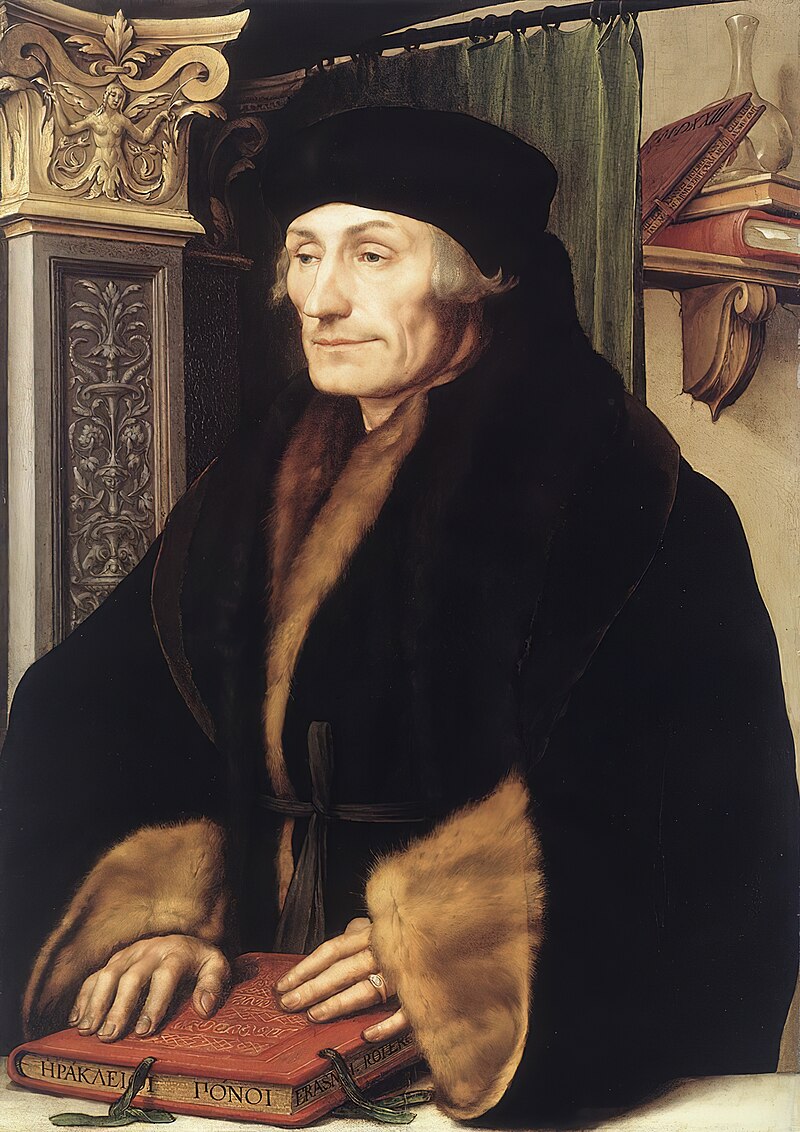
Above: Desiderus Erasmus of Rotterdam (1466 – 1536)
Zwingli took the opportunity to meet Erasmus when the Dutchman was in Basel between August 1514 and May 1516.
Zwingli´s turn to relative pacifism and his focus on preaching can be traced to the influence of Erasmus.
Einsiedeln, Switzerland, 23 November 2017
At the beginning of the 16th century the monastery was headed towards total disintegration.
The Schwyzians, the patrons of the monastery, stepped in and turned to St. Gallen for a new abbott.

Above: Coat of Arms of Canton Schwyz
He saved the monastery by opening up the novitiate to commoners.
The monastery complex was rebuilt from 1704 to 1726 in the most lavish of late-Baroque styles, the handiwork of monk Kaspar Moosbrugger.
The baroque Abbey was still new when the French occupied Switzerland after the Revolution.
On 3 May 1798, 6000 soldiers under General Schauenburg invaded the area, confiscated the Abbey and expelled the Abbot and monks.
On their flight to St. Gerold in Austria, they were able to take only their most valuable possessions.

Above: Benedictine monastery, Sankt Gerold, Austria
Schauenburg allowed his soldiers to plunder the Abbey and in the two weeks that followed they removed everything they could carry away.
The officers made one another presents to the magnificent horses from the Abbey stables, the library was completely sacked and the Church desecrated.
The miraculous statue of the Black Madonna was dispatched to Paris where it proved to be an imitation.
The monks had replaced the original before the arrival of the French and smuggled it to Austria.
To put a stop to pilgrimages for all time, the French then destroyed the Lady Chapel.
Three years later, after Napoleon had seized power in France, the Abbott and monks were able to return – to a picture of devastation.
In the 19th and 20th centuries the monastery´s sphere of activities entered a period of marked growth.
In 1854 it founded the Archabbey of St. Meinrad in Indiana, and in 1925 worked to establish an agricultural school in Pfäffikon on the Lake of Zürich.
Above: St. Meinrad Archabbey Church, Indiana
In 1948 the Abbey founded the Priory of Los Toldos in Argentina.
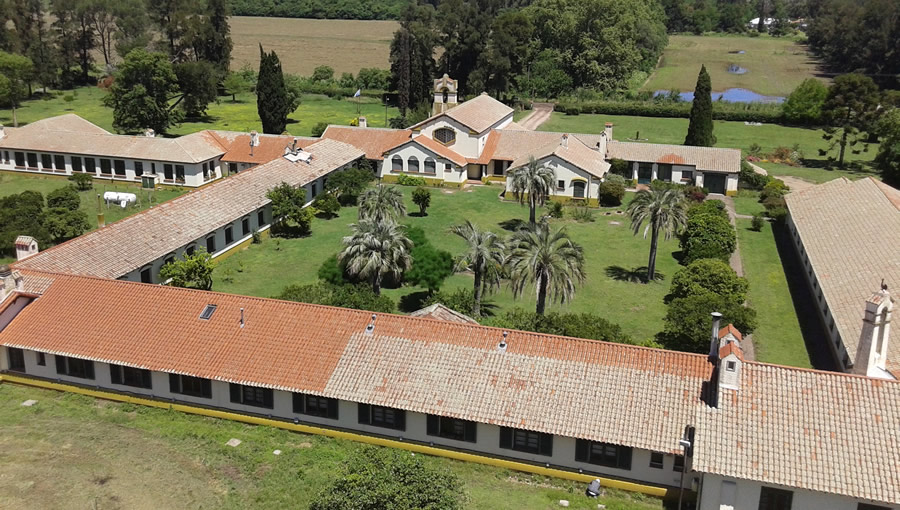
Above: Monasterio Benedictino Santa Maria, Los Toldos, Argentina
The former small abbey school was expanded into a grammar/high school which is frequented by 300 boys and girls.
In 2008 the convent numbered 80 monks.
Einsiedeln´s train station and post office are in the town centre opposite Dorfplatz.

Above: Einsiedeln Train Station
I headed through this square and turned left onto Hauptstrasse, following other obvious tourists flowing towards this edifice at the end of the street overlooking Klosterplatz – a ten-minute walk.
As you emerge from the cluster of the village centre, the vast Klosterplatz opens out in front.
The rather plain sandstone front of the Church, with its twin towers rising from an immense 140 metre long facade, is framed by unusual semicircular sunken arcades.
The ornate Well of Our Lady in the square taps the waters of Meginrat´s spring – pilgrims traditionally drink from each of the fourteen spouts in turn on their approach to the Church.
The interior is breathtaking.
The nave is decorated with detailed frescoes by Cosmas Damian Asam.
Every part of the lofty white interior is detailed in lavish gold.
An intricate wrought-iron choir screen gives into the stunning pink Rococo choir with a ceiling bedecked with animated sculptures of angels.
However the focus of all the pilgrims´ attention is the black marble Chapel of Our Lady, positioned in a huge octagonal bay just inside the main portal.
The Black Madonna, a little over one metre tall and usually dressed in a jewelled and tasselled golden dress donated by Canton Uri in 1734, stands illuminated within.
Every day, the monks of Einsiedeln sing the anthem “Salve Regina” (“Hail to thee, oh Queen, Mother of Mercy”) in the chapel of the Black Madonna.
The Salve has been sung since 1547.
In his book Poetry and Truth, Goethe described the Chapel:

Above: Johann Wolfgang von Goethe (1749 – 1832)
“The little chapel in the church, the hermit´s cell inhabited by the saint, is encrusted with marble and as far as possible transformed into a decent chapel.
It was something new to me, something I had never seen before, this tiny compartment, surrounded and enclosed by pillars and domes.
It led me to think that a single spark of piety and morality had ignited an eternally burning flame to which crowds of pilgrims were to undertake their arduous journey in order to light their own candles at the holy flame.
Be that as it may, it indicates a deep longing on the part of humanity for the same light, the same warmth, such as the first hermit Meinrad drew from his deepest inner conviction.”
Pilgrims often ask:
“Why is the Madonna black?”
There is one obvious explanation: the soot from candles, incense and oil lamps has darkened the original colour gradually through the ages.
The flight from the French did the Madonna no good either, and she suffered greatly from damp weather.
Before the Madonna returned from Austria, an artist restored the statue returning the face and hands of the Virgin and the skin of the Christ Child the colour of flesh.
Then the monks in exile set the image up for a few days for public viewing in front of the church in Bludenz.

Above: The Priory of St. Peter, Bludenz, Austria
The appearance of a black Madonna had become so popular and the disappointment so great that the artist repainted the skin black.
It would never change.
Einsiedeln remains a fully functioning monastic community of 80 priests and 20 brothers.
Mass is celebrated several times a day.
Of the many annual pilgrimage festivals, the most colourful is the Feast of the Miraculous Consecration on 14 September, which culminates in a candlelit procession around the square.
Let me blunt.
My first gut reaction to Einsiedeln was, and mostly remains, here is yet another big fancy church.
I remember walking Jakobsweg (St. James Way) from Rapperswil to Einsiedeln.

(“Europe was created on St. James Way.”, Goethe once wrote.
He was not wrong, for the history of the St. James Way is deeply connected with the history of Europe and was therefore deemed a part of the world´s cultural heritage in 1987.
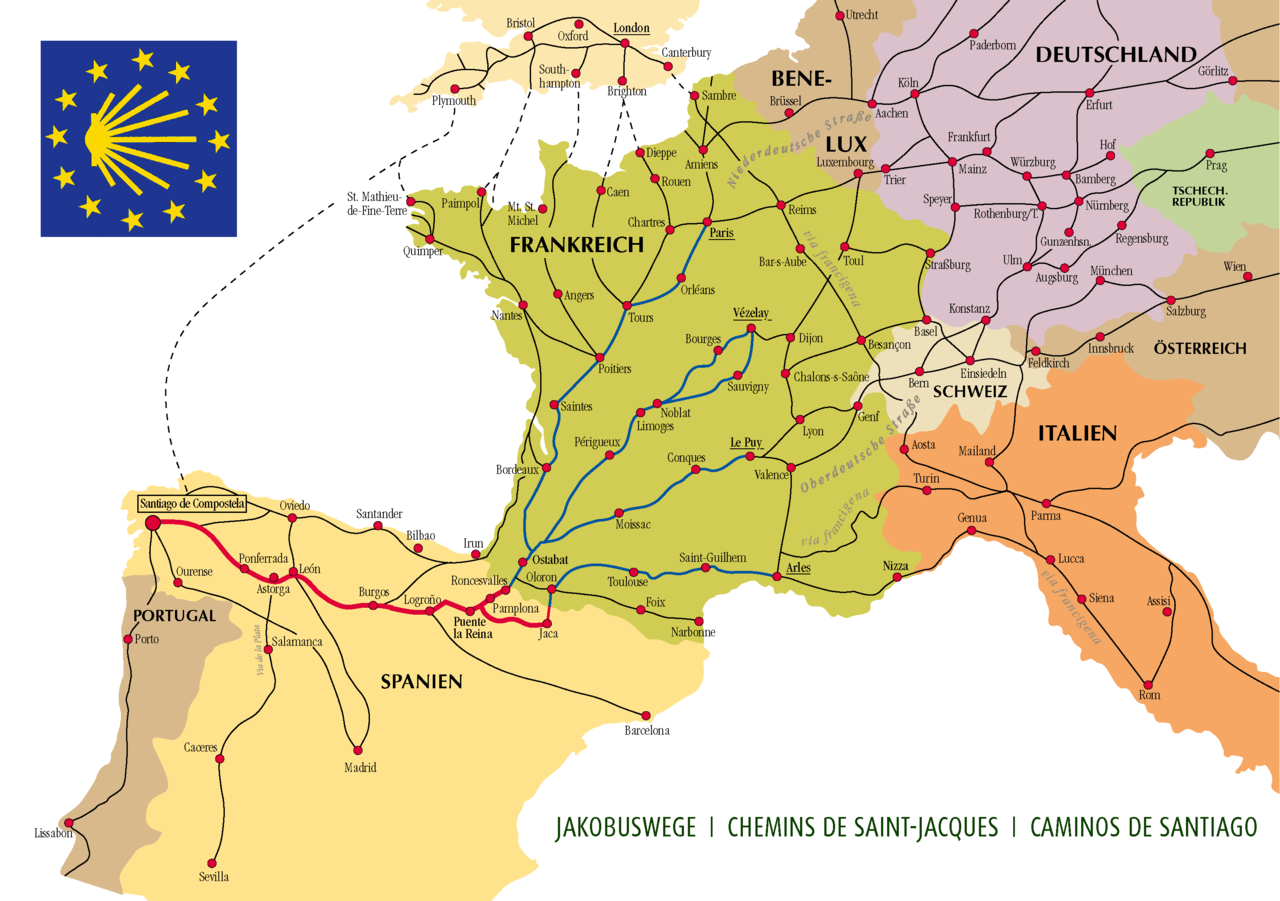
St. James Way consists of a wide net of routes which spread across Europe like many loose threads that intertwine as they head toward Santiago de Compostela in Spain where the supposed remains of St. James were found by a hermit in a neighbouring field.)
I remember visiting Einsiedeln with my wife in the first summer we lived in Switzerland (2010) and feeling overwhelmed by the thousands of tourists that seemed to be visiting the Abbey that same day.
But I know that Einsiedeln Abbey and the town itself deserved a second look.
Einsiedeln, Switzerland, 4 January 2018
(For more on this day, please see …and the ravens cried “Nevermore” of my other blog Building Everest.)
To the non-follower of Catholicism, the cult of Marianism (the veneration of Mary, the mother of Jesus, as being divine because God decided to choose her to bear His Son, thus making her the instrument through which we can get intercession from God) seems quite strange and somewhat smacking of idolatry.

Yet this veneration of Mary encompasses prayer, acts of piety, visual arts, poetry and music.
Popes encourage it, but are always cautioning Catholics not to confuse respect for her duty with any actual divinity said duty may have given her.
Let there be no doubt.
Einsiedeln Abbey is most definitely a Marian pilgrimage site.
In 1996, the working group Shrines of Europe was founded with the purpose of uniting Europe´s principal Marian pilgrimage sites, which now are listed as Fatima, Portugal; Altötting, Germany; Loreto, Italy; Czestochowa, Poland; Lourdes, France; Einsiedeln, Switzerland; and Mariazell, Austria.

“At all these holy places, pilgrims hope to gain a new sense of the message given to them by their belief.
The strain and occurences which they experience on their way there give them more insight.
Their experiences at the holy place itself provide many people with new strength and energy – for the story they hear of the shrine, the rituals which are held, and the praying people all create an atmosphere in which the soul can open and find peace.”
A wet and stormy day finds me back in Einsiedeln on this my first day off after two days working.
I revisit the Abbey Church and remain impressed by the frescoes and stucco works and the gorgeous Baroque architecture.
I wonder at the devotion of the half-dozen worshippers praying by the Lady Chapel´s Black Madonna.
I will miss hearing the Gregorian Vesper at 1630 and the Salve Regina singing that will follow, but console myself with the thought of buying an audiovisual record of them in the Cloister Shop.
I view the Great Hall, the audience chamber of the monastery and can well imagine a concert filling the place with magnificent music.
I long to visit the Abbey Library with rare manuscripts and books Dating back to the foundation of the monastery in the 10th century, but am told that the Library can only be visited as part of a large guided German-language tour.
I risk life and limb walking treacherous ice to visit the stables behind the monastery to find lady grooms unwelcoming and horses indifferent.
The monastery´s stables are considered to be the oldest stud farm in Europe still in operation.
The baroque stables were built between 1764 and 1767.
Einsiedeln Abbey horses were highly admired all over Europe.
In Italy they were known as the Cavalli della Madonna (the Madonna´s cavalry).
Yet there is more to Einsiedeln than just the Abbey, for it is a place not only of pilgrimage but as well culture.
See the Jerusalem Panorama that shows the Crucifixion from Good Friday until All Saints´ Day.
See the Bethlehem Diorama illustrating the Christmas story complete with announcement-receiving shepherds, the Nativity Scene (minus a little drummer boy), the arrival of the Three Kings (no, not George Clooney, Mark Wahlberg and Ice Cube, but instead Caspar, Melchior and Balthazar) and the Holy Family´s escape to Egypt, from All Saints´ Day to Epiphany.
Cross the Devil´s Bridge, a stone bridge covered by a wooden roof on St. James Way, constructed in 1699 to transport the stones needed to construct the monastery from the quarry on the Etzel River to Einsiedeln.
In the middle of the bridge is a statue of St. John of Nepomuk.
The famous physician Paracelsus was born close to the bridge in 1493.

Above: Theophrastus von Hohenheim aka Paracelsus (1493 – 1541)
I will never again make a gingerbread latté without thinking of the Goldapfel Gingerbread Bakery Museum with its old baking utensils and wooden forms, and the sale of Schaffböcke, or pilgrim biscuits, made from flour, water, honey and spices or the brown and white filled Kräpfli or speciality gingerbread.
In the cellar of the Bethlehem Diorama is the Museum of Minerals, a collection of over 1,000 minerals from all over the world – from Alpine quartz to colourful crystals from China and South America.
A special feature is the flourescent cabin where inconspicuous stones reveal an unexpected blaze of colours under ultaviolet light.
The Fram Museum is an historical museum about Einsiedeln, dedicated to the most important events during the town´s long history, including the Benzinger Publishing Company and the famous physician/alchemist Paracelsus.
And there are activities to enjoy besides museums and buildings of holy intent:
You can swim off Roblosen Beach on Lake Sihl, or in the Hallenbad indoor swimming pool or at the Alpamare water park.
Cruising on Switzerland´s largest reservoir, Lake Sihl, is an unforgettable natural experience.

Catch a movie in the cinema, play minigolf, take a horse-drawn carriage ride, enjoy a ride aboard the Blatten Garden steam train, take a tandem hang glide, indulge yourself with a luxury tour on an original Rolls Royce Silver Shadow, visit the largest and newest indoor beach volleyball complex in Switzerland or play on one of three outdoor volleyball courts.
There are bike paths and hiking trails, rope parks and rope slides, an 18-hole golf course and windsurfing on the lake.
There is a cable car, Europe´s longest hanging footbridge, a summer toboggan run, a bouncy castle and playgrounds for the kids in nearby Sattel.
Not far away in Gossau, you can visit the Landscape and Animal Park – 34 hectares that is home to more than 100 different native and European species living in almost wild conditions.
Feed the deer, see the bears, howl with the wolves.
The military buff amongst the group will be delighted to find that the Canton of Schwyz has the Reduit Defence Line, a series of more than 400 interconnected fortifications, restored and refurbished with original Equipment including Fort Grynau, antitank defences, artillery casemates, a control centre and a fire control post.
Between Einsiedeln and the Lake of Zürich in Schindellegi, you can experience the most modern ski jumps in Switzerland and the training ground of four-time Olympic gold medal winner Simon Ammann up close and personal.
A resurrected Meinrad the Hermit probably would no longer recognize what Einsiedeln has become, but I have the distinct impression he might not be displeased at what he would see.
Sources: Wikipedia / Google / Monika Hanna, Der Schweizer Jakobsweg: Vom Bodensee zum Vierwaldstättersee / Marcel and Yvonne Steiner, Zwingli Wege: Zu Fuss von Wildhaus nach Kappel am Albis / Rough Guide to Switzerland / Einsiedeln Tourismus / Kloster Einsiedeln

